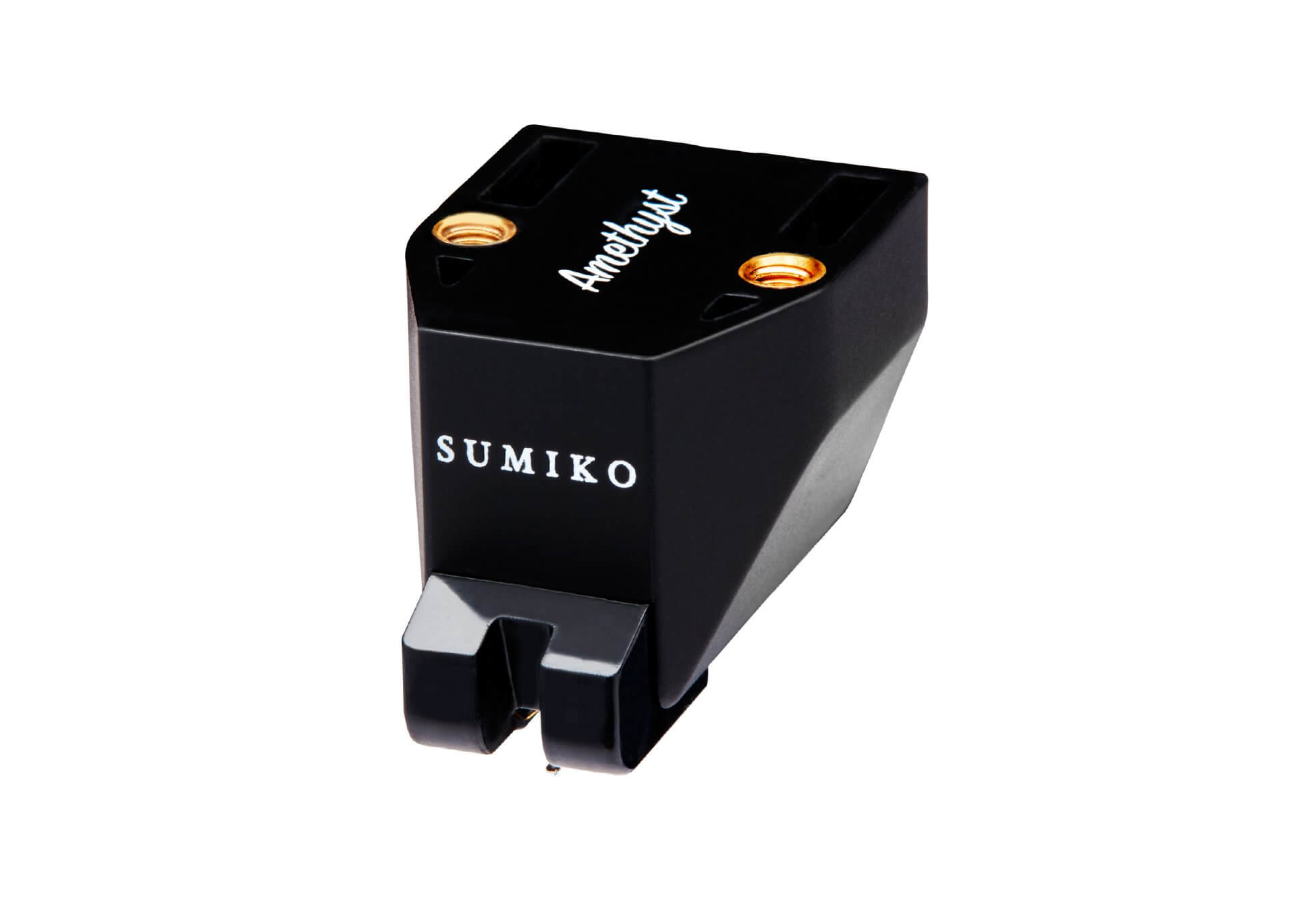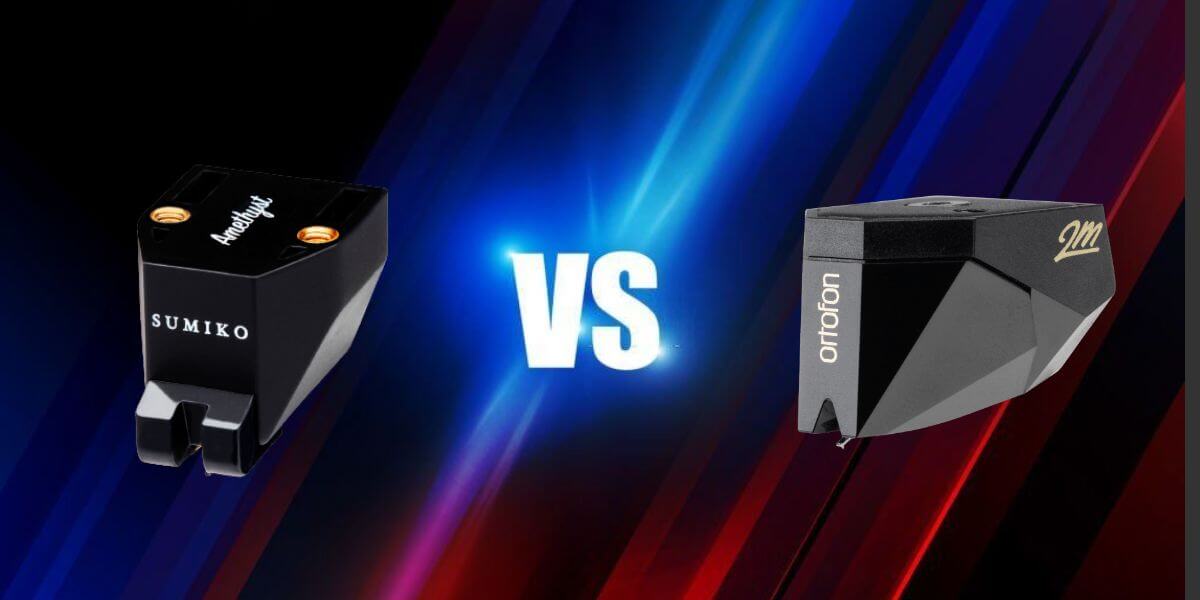Whether you’re ready to step up your turntable experience or you’re planning on starting strong, there are plenty of options and models to consider. Among the most popular names in the moving magnet cartridge industry are Sumiko and Ortofon.
These two brands have graced us with a variety of moving magnet cartridges that you can fit into almost every modern turntable available today, such as the Pearl and the 2M Series.
In today’s guide, we’ll put their flagship models the Sumiko Amethyst vs the Ortofon 2M Black in a head-to-head comparison to see which one of them is the better pick for you. So without further ado, let’s dive right in!
Sumiko Amethyst vs. Ortofon 2M Black Overview
The Sumiko Amethyst and the Ortofon 2M are both top-tier moving magnet cartridges. The Amethyst is a more price conscious choice with better audio details while the 2M Black gives you a noticeably more enjoyable warm tune while being more forgiving on vintage records.
| Image | Product | Detail | Price |
|---|---|---|---|
 | Sumiko Amethyst |
| Price |
 | Ortofon 2M Black |
| Price |
What Is Sumiko Amethyst?
Sumiko is one of the most popular names in the phono cartridge industry for all the good reasons!
The Japanese company has been around for over 40 years, with plenty of its products ranking very high among buyers’ choices. This is because Sumiko is always focused on building a wide range of cartridges that meet everyones’ budgets and needs.
The Sumiko Amethyst is the highest-tier model that belongs to the Oyster Series of moving magnet cartridges. This one is particularly designed for those who don’t mind spending more money in order to enjoy a top notch turntable experience.
As you might’ve expected, Sumiko goes full power when it comes to this model. It features a 0.2 x 0.8 mil line contact stylus along with an improved generator assembly to ensure impressive performance while keeping the noise level to a minimum.
Unlike lower-tier models, this model uses a nude diamond tip instead of bonding it to a metal, which improves the sensitivity of the stylus and reduces record wear.
These improvements highly improve the acoustic performance of the cartridge and allow you to experience the most realistic and accurate playback quality available
The enhanced assembly and engineering of the Amethyst also offer a wider frequency response range than other options of the Oyster lineup, extending from 12 Hz all the way up to 35,000 Hz.
The output voltage is also remarkably reduced to improve the overall audio quality and match the high end phono stages used with this model.
What Is Ortofon 2M Black?
Although the Danish company has been around for over a century, Ortofon is still incredibly popular to this day, especially when it comes to its 2M moving magnet lineup.
This one includes the 2M Red, Blue, and Bronze. However, the Ortofon 2M Black is the highest end model of this series and boasts the most exquisite features and properties.
Since the stylus makes almost all the difference in sound quality and details, it’s no wonder that the 2M Black will have the most outstanding tip out there.
The Shibata style tip is characterized by its remarkably thin tip, which allows it to pick up even the tiniest of musical details.
The stylus is mounted on a durable aluminum tube cantilever that offers great audio transmission. This aspect is one of the differences between the regular 2M Black and the 2M Black LVB 250, which features a better-performing boron cantilever.
As for the housing, this one has the same outer shell design as the rest of the series. Despite that, its stylus is only replaceable with the 2M Bronze assembly.
In terms of the overall design, the 2M Black is one of the most aesthetically pleasing cartridges that you can fit into your tonearm. It’s also fairly easy to install and align, which also adds to the value of the product.
Recommended: Sumiko Blue Point 2 vs. Ortofon 2M Bronze
How Are They Different?
Although both the Amethyst and the 2M Black are the top tier options of their respective series, they vary significantly because they use different styli.
The Amethyst uses a Nude Fine Line stylus, at 0.2 x 0.8 mil, this one is relatively thinner than the Shibata stylus attached to the 2M black.
A thinner stylus means a better ability to pick up tiny details without buzz noises, and in fact, any fine line stylus is immediately recognizable due to the absence of that hum.
However, a fairly thicker stylus that is still a bit thin is usually more forgiving on vinyl record surfaces. This means it causes less damage after long term use, especially on older vinyl records.
Another aspect where these two vary is their compatibility. The Sumiko Amethyst’s engineering makes it practically incompatible with other Pearl models, such as the Rainier, Moonstone, and Olympia.
In other words, you won’t be able to upgrade to the Amethyst unless you buy the full assembly. On the other hand, the 2M Black is compatible with the 2M Bronze.
This means that you can upgrade to the 2M Black simply by swapping the 2M Bronze stylus for the 2M Black one and save the difference.
How Are They Similar?
The similarities between the Amethyst and the 2M Black are mostly focused on the sound quality.

Compared to other models from their respective lineups, both of them offer a more harmonically rich tune, even across different genres, although the individual difference between the two would slightly show if you play the same samples on each one of them back to back.
The two cartridges also share various similarities in terms of specifications and build materials, as they both use the same type of materials for cantilevers, magnets, and coils.
What’s Better About Sumiko Amethyst?
The Sumiko has various aspects where it may surpass the Amethyst. For example, theoretically, the amethyst has a fairly thinner stylus, which usually translates to better audio quality.
You can also notice the clear edge of the Amethyst when it comes to the frequency range, which extends from 12 to 35,000 Hz.
This is a much wider range than the 20 to 20,000 Hz of the 2M Black and helps in digging up more details.
Another aspect where the Sumiko Amethyst is a better choice is the price, as it’s also considerably more affordable than the 2M Black while offering similar overall performance and build quality.
Related: Ortofon RS 309D review
What’s Better About Ortofon 2M Black?
The listening experience of the Ortofon 2M Black is generally more relaxed than the Sumiko Amethyst.
Compared to the 2M Bronze (which also has a fine line stylus), the Amethyst had more bloom and better bass, although the mid and top end details were similar. Yet, this advantage doesn’t hold still when the Sumiko Amethyst is compared to the 2M Black.
The tunes of the 2M Black are generally smoother and warmer than its Japanese competitor, which is preferred by many audiophiles, especially in genres with a lot of instrumental music.
Despite being more expensive, the nude Shibata stylus of the 2M Black is usually more durable than the nude Fine Line stylus of the Amethyst, so you’ll need to replace the stylus less often.
The aligning process of the 2M Black is also much easier than the Sumiko Amethyst because the stylus is not too thin.
Who Should Get Sumiko Amethyst (And Why)?
The Sumiko Amethyst is an excellent choice for any audiophile who enjoys high quality audio with powerful bass and enjoys a slightly bright tune.
It’s also a better choice if you have a relatively limited budget, as the Sumiko Amethyst is somewhat cheaper than the 2M Black, although not by a huge margin.
Who Should Get Ortofon 2M Black (And Why)?
The 2M Black is ideal for anyone who is looking for an unmatched listening experience while keeping the cartridge elegant and easy to install.
Additionally, if you typically play vintage vinyl records or use them extensively, you can go for the 2M Black because it will cause much less record wear over time, which protects them from long term use and damage.
Related: VM95E vs. Ortofon 2M Red
Features and Specifications Comparison Summary
| Spec/Feature — Cartridge | Sumiko Amethyst | Ortofon 2M Black |
| Cartridge Type | Moving magnet | Moving magnet |
| Cartridge Construction | ABS Polymer | ABS Polymer |
| Coils Construction | Ultra pure copper | Ultra pure copper |
| Stylus Type | Nude special line contact diamond | Nude Shibata diamond |
| Frequency Response | 12 to 35,000 Hz +/- 3 dB | 20 Hz to 20,000 Hz +/- 2 dB |
| Tracking Force | 1.8 to 2.2 grams | 1.4 to 1.7 grams |
| Suggested Tracking Force | 2.0 grams | 1.5 grams |
| Output Voltage | 2.5 mV | 5.0 mV |
| Load Impedance | 47k Ohms | 47k Ohms |
| Channel Balance | 0.5 dB at 1kHz | 1.0 dB at 1 kHz |
| Channel Separation | 30 dB at 1 kHz | 26 dB at 1 kHz |
| Cantilever Type | 0.5 mm aluminum Pipe | Durable aluminum |
| Internal Impedance | 700 Ohms | 1,300 Ohms |
| Item Weight | 6.5 grams | 7.2 grams |
| Interchangeable replacement Styli | RS Amethyst | 2M Bronze and 2M Black LVB 250 Replacement Styli |



